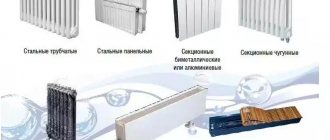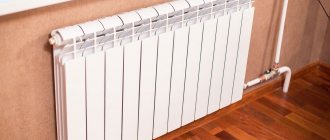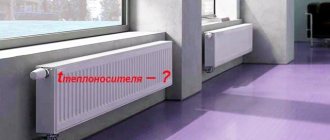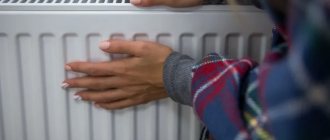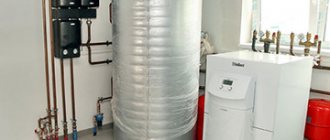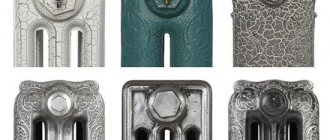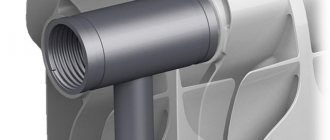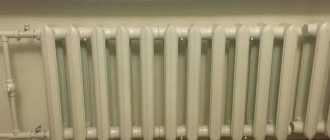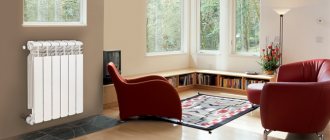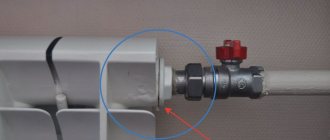To heat your home efficiently, you should buy high-quality elements. Before this, make the correct calculation of their power.
When calculating, heat loss from housing should be taken into account.
Calculations are made taking into account:
- room area;
- the height of its ceiling;
- number of windows,
- length of the room;
- climate features in the region.
You can calculate the performance of devices on your own. To do this, you need to know how many kW are in 1 section of an aluminum radiator or a cast iron, steel, bimetallic analogue.
How many kW in one section of an aluminum radiator
The thermal power of an aluminum radiator section depends on the volume of water contained in it. Standard volumes are 0.35 and 0.5 l.
Aluminum batteries give off heat 50-60% by radiation and 40-50% by convection. The air cutter enhances convection by 20-25%, which increases heat transfer.
At an air temperature of 20-24 °C and water temperature in the circuit of 65-70 °C, the thermal power of one aluminum section is:
- Volume 0.35 l., without cut-off – 0.1-0.12 kilowatts;
- Volume 0.35 l., with cut-off – 0.12-0.13 kilowatts;
- Volume 0.5 l., without cut-off – 0.155-0.170 kilowatts;
- Volume 0.5 l., with cut-off – 0.170-0.200 kilowatts.
It is difficult to name the exact amount of heat transfer - it depends on the design features, the diameter of the pipes, and the thickness of the fins. Performance is affected by the type of battery connection, water pumping speed, and contamination of internal surfaces.
Conclusion
Having found out how many kW there are in 1 section of a steel radiator or an analogue made of another metal, you can calculate the heat transfer of the purchased product. This will allow you to install an efficient heating system in your home.
The video in this article continues to clearly inform you on the topic.
In order for the heating of your home to be effective, you need to purchase high-quality elements. Before this, make a correct calculation of their power.
Calculations are made taking into account:
- room area;
- the height of its ceiling;
- number of windows,
- length of the room;
- highlights of the climate in the region.
It is possible to calculate the performance of devices on your own. To do this, you need to know how many kW are in 1 section of an aluminum radiator or a cast iron, steel, or bimetallic analogue.
Negative reviews
Before choosing an aluminum radiator, you should read consumer opinions, which are not always positive. For example, some buyers note that water leaks are sometimes noted at intersectional joints. The heat distribution in such batteries is uneven. It focuses on the ribbed surface.
Buyers also do not like the fact that the convection return is very small. Such a battery may not last long - up to 15 years. But some manufacturers have corrected this shortcoming by increasing the warranty to 25 years. Buyers quite often refuse aluminum radiators for another reason that they are chemically reactive, so corrosion is a serious enemy for these devices. But manufacturers introduce anti-corrosion treatment into the production process, covering the surface with a layer of oxide film.
Calculation by volume
Calculating the heat transfer of a battery by room volume is a little more complicated. To do this, you will need to know the width, length and height of the room, as well as the heating standards established for one m3 - 41 W.
What kind of heat transfer should bimetallic radiators have for a room 3x4 m, taking into account the ceiling height of 2.7 m: V = 3x4x2.7 = 32.4 m3. Having received the volume, it is easy to calculate the heat transfer of the battery: P = 32.4x41 = 1328.4 W.
As a result, the number of sections (taking into account the thermal power of the battery at high temperature mode 200 W) will be equal to: K = 1328.4/200 = 6.64 pcs. The resulting number, if it is not an integer, is always rounded up. Based on more accurate calculations, you will need 7 sections, not 6.
Pros and cons of using cast iron radiators
Stylized cast iron radiator
Any heating system that exists today has both pros and cons, let’s look at them.
The rated thermal power of each section is 160W. Approximately 65% of the released heat flux heats the air accumulating in the upper part of the room, and the remaining 35% warms the lower part of the room.
- Long period of use, ranging from 15 to 50 years.
- High level of resistance to corrosion processes.
- Possibility of use in heating systems with gravitational circulation of coolant.
- Low efficiency of heat transfer index correction;
- High level of labor intensity during installation;
Important! In order not to encounter problems during installation, be sure to take into account the above-mentioned pros and cons of cast iron radiators. Their installation is not cheap, and repeated installation work will require a lot of financial resources.
Calculation of sections (cavities) of radiators
So, how many kW is in 1 section of a cast iron radiator? To calculate the number of sections and their power, it is necessary to determine the V of the room, which will later appear in the calculations. Next, select the value of thermal energy. Its meanings are as follows:
- heating 1 m 3 houses made of panels - 0.041 kW.
- heating 1 m 3 of a brick house with double-glazed windows and insulated walls - 0.034 kW.
- heating 1 m 3 of premises built according to modern building standards - 0.034 kW.
The heat flow of one cavity of MS 140-500 is 0.160 kW.
Next, the following mathematical operations are carried out: the volume of the room is multiplied by the heat flow. The resulting value is divided by the amount of heat generated by one cavity. We round the result up and get the required number of sections.
How many kilowatts are in the cast iron section? Each type of radiator has a different value, which the manufacturer calculates during their manufacture and indicates it in the accompanying documentation.
Let's make an approximate calculation based on the available data.
The room has the following data: type of room - panel house, length - height - width - 5x6x2.7 m, respectively.
- We calculate the volume of the room V:
- Based on this, the number of radiator sections is as follows:
where 0.16 is the thermal power of one section. Specified by the manufacturer.
- We round the value up, based on which the number of required sections is 21 pieces.
Important! Always round the resulting value up. If it’s hot, you can ventilate it; if it’s cold, you can’t heat it up.
Main types
Cast iron radiators M-140
Radiators type M-140 have a fairly simple design and are easy to maintain. The material used in their manufacture is cast iron. It is highly resistant to corrosion processes and can be used with any coolant. The low level of hydraulic pressure allows the use of radiators for both gravitational and forced coolant circulation systems. The high threshold of resistance to hydraulic shocks allows them to be used in both two-story and nine-story buildings. The advantages of the M-140 are ease of maintenance, reliability, long service life and low cost.
Cast iron radiators MS-140-500
They are widely used for heating buildings with a coolant temperature within 1300C and a pressure of 0.9 MPa. The capacity of one cavity is 1.45 liters, the volume of the heated area is 0.244 square meters. The material used for the manufacture of sections is SCh-10 (gray cast iron).
Cast iron radiators MS-140-300
Radiators used to heat rooms with low window sills and a pressure of 0.9 MPa. Cavity capacity - 1.11 l. The weight of the cavity including components is 5700 g. The strength of the calculated heat flow is 0.120 kW.
Cast iron radiators MS-140M-500-09
Radiators of this model are used for different rooms with a coolant temperature of up to 1300C and a pressure of 0.9 MPa. The mass of one cavity is 7100 g. The material used for manufacturing is gray cast iron. S heating with one cavity - 0.244 m2.
Important! When choosing a radiator for your home, be sure to pay attention to its characteristics and make all kinds of calculations in advance, since it will be almost impossible to exchange the purchased product.
Compliance with State Standards
For all heating systems and their elements there is a single register of State Standards, which they must comply with. Everything is taken into account:
- Quality and safety of production.
- Compliance with temperature conditions and pressure in pipes.
- What should be indicated in the data sheet of the finished product.
- Standards according to technical characteristics and permissible deviations from the norm.
If you want to buy bimetallic radiators, GOST will tell you what parameters they should have, and they must correspond to the indicators in the documentation for each product. If they do not match, it is better not to purchase such products.
What is heat transfer?
Heat flow, power and heat transfer of bimetallic radiators are different designations for the same parameter, which determines the amount of heat generated by the device over a certain period of time. The parameter changes in Watts. Sometimes it is expressed in calories per hour. Converting the value to the desired unit is simple: 1 Watt = 859.8 cal/hour.
The heat coming from the bimetallic radiator warms the room as a result of three processes:
- Heat transfer.
- Convection.
- Radiation.
All bimetallic devices “use” all three types of heating, but the proportions may be different. In the standard case, at least 25% of the thermal energy is transferred from the device to the surrounding space through radiation.
Thermal power
The photo shows the approximate heat transfer of cast iron.
In the room, heating devices are placed against the outer wall under the window opening. As a result, the heat emitted by the device is distributed optimally. The cold air coming from the windows is blocked by the heated air flowing upward from the radiator.
Cast iron batteries
Cast iron analogues have the following advantages:
- have a long service life;
- have a high level of strength;
- they are resistant to corrosion;
- Excellent for use in utility systems operating on low-quality coolant.
- Now manufacturers produce cast iron batteries (their price is higher than conventional analogues), which have an improved appearance thanks to the use of new technologies for casting their housings.
Disadvantages of products: large mass and thermal inertia.
The lower table states how many kW is in a cast iron radiator, based on its model.
| Radiator model | Thermal power of one section in Watts |
| MS-140/M-2 | 160 |
| MS-140/M-300 | 117 |
| MS-90 | 130 |
| T-90/M | 127 |
Note! To heat a room with an area of 15 m², the power, that is, kW of a cast iron radiator, must be at least 1.5. In other words, the battery should consist of 10-12 sections.
Aluminum radiators
This is how the heat transfer of aluminum products changes.
Aluminum products have greater thermal power than cast iron counterparts. When asked how many kW is in one section of an aluminum radiator, experts answer that it reaches 0.185-0.2 kW. As a result, for the standard level of heating of a fifteen-meter room, 9-10 sections of aluminum sections will be sufficient.
The advantages of such devices:
- a light weight;
- aesthetic design;
- high level of heat transfer;
- You can control the temperature yourself using thermostatic valves.
But aluminum products do not have the same strength as their cast iron counterparts, for example a 2 kW oil radiator. Therefore, they are sensitive to surges in operating pressure in the system, water hammer, and excessively high temperature of the coolant.
Note! When water has a high pH (acidity) level, aluminum releases a lot of hydrogen. This negatively affects our health. Based on this, it is advisable to use such devices in a heating system in which the coolant is neutrally acidic.
Bimetallic products
The structure of a bimetallic product.
Before you find out how many kW are in 1 section of a bimetallic radiator, you should take into account that such batteries have similar operational parameters to their aluminum counterparts. However, they do not have any inherent disadvantages.
This circumstance was determined by the design of the devices.
- They consist of copper or steel pipes through which coolant flows.
- The tubes are hidden in an aluminum plate housing. As a result, the water circulating inside does not interact with the aluminum of the case.
- Based on this, the acidic and mechanical characteristics of the coolant do not in any way affect the operation and condition of the device.
It is steel pipes that provide the bimetallic product with excellent technical characteristics.
Thanks to the steel pipes, the device has high strength. Increased heat transfer is ensured by external aluminum fins. When trying to find out how many kW is in a steel radiator, keep in mind that bimetal has the highest heat transfer - about 0.2 kW per fin.
Standard calculation method
According to building codes, for each square meter of living space, approximately 100 W of heating power is required. The required number of heating battery segments is calculated by the formula: N = S*100 / P, where P is the power of one section, and S is the area of the room.
As an example, let's calculate the number of radiator segments with a power of one segment of 180 W for a room with an area of 22 m2.
N = 22*100/180 = 12.22 ≈ 12
There is an even simpler formula. With a ceiling height of 2.5 to 2.7 m, we can assume that one section is required per 1.8 m2 of room area, from which:
For our example we get:
N = 22 / 1.8 = 12.22 ≈ 12
As you can see, the result is the same: 12 segments are needed. But it should be borne in mind that with low power of the heating device, the second (simplified) method can give a big error.
Advantages of cast iron heating radiators
Heating appliances made of cast iron are very resistant to aggressive coolant environments. This is explained by the physical parameters of this metal. Cast iron radiators can remain corrosion-free for a very long time, even at elevated temperatures. In addition, virtually no harm is caused to cast iron and various chemicals added to the coolant.
If the device becomes clogged or leaks, they can be easily repaired. Blockages that occur in the radiator can be caused by the properties of the coolant with a high content of Ca and Mg salts. As a result of deposits on the inner wall of the device, it narrows, which leads to a deterioration in the heating rate and normal heat transfer. A leak in a cast iron battery can occur as a result of wear of the gaskets between the sections. It is better to eliminate all the problems described above during the summer preventive shutdown of water supply.
The cost of a cast iron battery is approximately equal to the cost of analogues made of aluminum and steel. But at the same time, it is worth noting that cast iron withstands water shocks much better and can withstand pressure surges of about 16 bar.
Cast iron devices can be used at high temperatures and pressures, due to their low coefficient of thermal expansion.
The heat output of the heater is quite high. To achieve the greatest effect from this property, special reflectors should be placed behind the cast iron radiator.
Installation of a cast iron radiator is easy, due to the fact that the radiator sections are connected using a threaded connection and paronite gaskets. The battery is connected to the ends of the pipes in the same way. A special key is used for threading, which can be used to disconnect any section without removing the side ones.
Very long product life of more than 50 years. The only thing is that during this time it is necessary to regularly remove deposits and replace gaskets.
